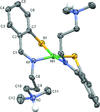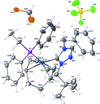issue contents
July 2017 issue

Cover illustration: The heterometallic coordination compound [Cu(Lys)(phen)]2V4O12·4H2O (Lys is the amino acid lysine, C6H14N2O2, and phen is 1,10-phenanthroline, C12H8N2) lies across an inversion centre and features the [V4O12]4- polyoxovanadate anion acting as a bridging ligand for two [Cu(lysine)(1,10-phenanthroline)]2+ fragments. The [V4O12]4- ring system is of interest in coordination chemistry, given that this anion may behave as a bridging ligand, providing an entry to heterometallic complexes. Within the sub-set of heterometallic complexes containing V and Cu as transition metals for which an X-ray characterization is available, this compound is the first one including an amino acid, namely lysine. See: Giron-Moreno, Lara-Sánchez, Moreno-Martínez, Pastor-Ramírez, Sánchez-Lara & Sánchez-Morales [IUCrData (2017). 2, x171050].
metal-organic compounds


 access
access

 access
access

 access
access

 access
access

 access
access

 access
access

 access
accessorganic compounds


 access
access

 access
access

 access
access

 access
access

 access
access

 access
access

 access
access

 access
access

 access
access

 access
access

 access
access

 access
access

 access
access

 access
access

 access
access

 access
access

 access
access

 access
access

 access
access

 access
access

 access
access access
access

 access
access

 access
access

 access
access

 access
access

 access
access

 access
access

 access
access

 access
access

 access
access

 journal menu
journal menu

















































![[publCIF]](/logos/authorchecklist11.gif)





